What Happens If Lava Touches Skin
Here's What Would Happen If You Touched Lava
There's simply something near lava, isn't there? Information technology'south so smooth and almost silky-looking, peculiarly when it's the kind that crawls along the ground. It doesn't even really seem to affair that information technology'south obviously going to hurt, there's something that just makes a person want to reach out and...
Don't. Simply put? Just don't do information technology. Yeah, information technology's hot, and yep, it'south going to do some serious damage. But it turns out that it's more than complicated than that. According to the U.Southward. Section of the Interior, there are effectually 1,500 active volcanoes in the world — and 169 of them are in the U.S. There's a lot of reasons scientists might want to get up close and personal with them, but even the volcanologists who are e'er on the watch for new means to monitor lava flows and predict disasters are happy to let things like satellites do a lot of the heavy lifting (via Nature).
It's ameliorate that way, considering nosotros meet too often what happens when people and volcanoes get too shut. In 2019, New Zealand's hospitals were overwhelmed with burn victims caught in the literal fallout from the Whakaari volcano. Doctors described them (via The Guardian) as having injuries that it would "take months to years to recover from, with significant scarring and possible loss of function." And they didn't even bear on the lava.
Permit's talk about just what you're touching
Not all lava is created equal, and so allow's talk virtually but what it is. Magma, explains National Geographic, is what we call molten rock when it'due south yet underground. When the same stuff escapes to the surface, that's when we phone call it lava. Pretty straightforward, right? So far, so good.
Lava tin can come in a ton of unlike speeds, shapes, and temperatures, and it'due south all dependent on what kind of stone it contains. Specifically, we're talking about silica content here, and simply put, that'southward a mutual mineral nosotros see more often — and more safely — in the form of quartz and drinking glass.
The college the silica content, the — to utilise a scientific term — goopier the lava is. Mafic magma and lava (like the stuff pictured) can have up to 63% silica, and that's the kind of lava that looks like honey or peanut butter that needs a good stir. Then, there's silicic lavas, which accept a per centum of silica greater than 63%, and that's the lava that just sort of lumps along instead of flowing. These are also the lavas that lead to the most spectacular explosions: They hold the gases inside rather than letting everything vent, and then whatever fourth dimension information technology's i of those cone-shaped volcanoes doing something catastrophic, information technology's commonly this kind of lava.
How hot is lava, anyway?
Anyone wanting to bear on lava knows they're touching something super hot, but how hot is hot? The respond is surprisingly complicated, and it depends on what kind of lava it is. National Geographic says that mafic lava — the runnier kind — is the hottest, and that makes sense: It'south the nearly melty. Those lava flows are hitting temperatures of up to 2,200 degrees Fahrenheit, and for a fleck of comparing, Space says that meteors blazing their mode through the temper reach temps of upwardly to 3,000 Fahrenheit.
Lava gets cooler from there, and according to the USGS, the color gives a pretty skillful indication of just how hot it is. Red lava is actually the coolest, and that's just between 1,112 and 1,472 Fahrenheit. Slightly hotter is the orange — betwixt i,472 and 1,832 Fahrenheit — and and then there's the yellow, which clocks in at somewhere between 1,832 and 2,192 Fahrenheit.
Cooling lava is a shockingly slow procedure, and in spite of the fact that exposure to the air tin make the temp drib by a few hundred degrees pretty rapidly, the USGS estimates that information technology can take upwards to six years for a lava flow to completely cool to the center.
In that location's i kind of lava that'south almost approachable
Volcanologists at Oregon State Academy say that in that location's i kind of lava that's "most approachable," but hither'south the disclaimer: Don't, considering information technology could nevertheless plough into a reenactment of the fiery fate of Anakin Skywalker.
Pahoehoe lava is the kind of lava that flows very slowly, and equally information technology moves, the surface starts to cool and a skin forms. That keeps nearly of the heat on the inside, but it'southward nevertheless hot enough to make the air shimmer. If you're wearing protective gear and approaching from upwind, that skin is enough to go on y'all from getting blistered and burned just from being in the vicinity, so... bonus?
Because that's exactly what tin happen if the lava skin breaks, or even if the wind shifts. Just being nearly it when that happens volition immediately cause pare to blister and skin. And touching it? Hither's some food for idea. The American Burn Association says that it takes just one 2d of exposure to temperatures of simply 155 Fahrenheit to cause third caste burns — and nosotros're talking about something around ten times as hot. Third degree burns are the kind that destroy skin and the tissue underneath, and require hospitalization and pare grafts to repair (via Medical News Today). And burns are simply the starting time of the problem.
If you're close plenty to touch lava, yous accept another problem
So, let's say someone does get close enough to touch lava. The heat from direct contact is just one part of the problem, and co-ordinate to the USGS, the gases the lava gives off tin can bring a whole new world of hurt.
Gases given off past lava include things like sulfur dioxide, hydrogen sulfide, and carbon dioxide. If those gases are trapped — or if the winds change and end bringing our theoretical lava-toucher fresh air — it can definitely be deadly. Air that's just iii% CO2 can cause dizziness and trouble breathing, and by the time that hits 15%, it'due south lights out. The same principle applies to the other gases, too, and it turns out that information technology doesn't take much to become deadly.
It's such a bad health risk that following the 2018 eruption of Hawaii'due south Kilauea, toxic fumes were traveling every bit far as 15 miles. Residents fled the gases — which are called vog — and according to The Guardian, not even breathing masks and respirators can filter out all the nastiness. If it's bad enough there's a recommendation to get off the isle, standing right next to information technology is definitely out.
Water can absurd lava and make it not-and so-unsafe... right?
What about a different country of lava — the kind that's dropping into the sea? The pictures are ever impressive, and when lava runs into the water, it kicks off a massive plumage that's surely cooling it and making information technology safe to touch... right?
Correct?
Absolutely not, says Michigan Technological Academy volcanologist Simon Carr (via The Verge). Information technology's not as simple as, say, dropping a bit of melting candy into cold water and watching it cool into a lump. When lava hits water, it's so hot that 2 things happen. First, the h2o boils abroad into nothingness, and the salt that's left behind is super-heated. So yes, the lava cools, just it turns into something called volcanic glass. That doesn't sink — it shatters into tiny pieces that combine with the evaporating sea water to create a feather of laze. What's laze? A super hot lava haze that'southward filled with tiny drinking glass particles and — thanks to some natural chemistry — muriatic acid.
Surely, not all the lava dissipates, right? Correct, says USGS volcanologist Michael Poland. Even as the lava cools, there's another problem for anyone who wants to go touch it — the freshly cooled lava is incredibly unstable, and with the addition of a person'south weight, there'due south a good run a risk that touching this lava would end with a potentially deadly dip in the body of water.
What if you dipped your mitt correct in in that location?
And so, what if you didn't just touch it, what if you lot stuck your hand right into the lava? Aside from being a terrible, terrible mistake, it would exist, well, maybe not as painful as you might expect for a very disturbing reason. USGS research chemist David Damby says (via The Verge) that sticking your hand in lava would "destroy nervus endings and boil subcutaneous fatty."
So, yikes. Let's look at what that means. Healthline says that in improver to the commencement, 2d, and 3rd caste burns that we usually hear about, in that location'south too fourth, fifth, and 6th degree burns. 4th is characterized past damage that destroys not only skin merely all the nerves and sometimes into the musculus. Fifth caste burns are burns that get all the way to the muscle, and sixth caste burns go right to the bone.
These burns are then bad that they don't hurt. All the nerve endings are gone, then while it's a much worse burn, the broken link betwixt the burning and the brain means that it's non nearly as painful. There's a whole laundry list of complications, including an immediate loss of claret pressure, dehydration, shock, and low body temperature. Longer-term complications are things like organ damage and amputation... and that's just quaternary degree burns.
What if you fell in?
Scientists — like Concord University volcanologist Janine Krippner — say (via The Verge) that falling into lava is another ane of those things that movies tend to get actually wrong. And that makes sense — lava is much thicker than water, then it's just logical that a person who brutal in wouldn't sink like they would if they fell into a lake. That person would merely sort of sit on the height... and, of course, burn down.
Just it turns out that it's not that simple. Geoscientist Erik Klemetti says (via LiveScience) that while that unlucky person was perched on the bed of molten lava, they'd ultimately meet their end when they burst into flames. That's the running theory, and since information technology's unethical to actually test it, there's still some wiggle room for statement.
In 2002, German scientists chucked a almost seventy-pound bag of leftover food into lava. Afterwards falling 260 anxiety, it started to burn and caused fountaining — spurts of lava. That's led to speculation that if someone fell from far enough, they — or rather, what was left of them — would sink at least a bit (via LiveScience).
Example Study: Anakin Skywalker
Since it's unlikely anyone's going to be trying this experiment in a applied way whatever time shortly — ethics, and all that other stuff — allow's have a wait at a fictional character who touched lava really, really hard: Anakin Skywalker.
Jeanne Cavelos suggests what would have happened if Anakin fell into a molten pit of lava, and it's in "The Science of Star Wars" (via Scientific American). She suggests that laying on the lava might minimize the burn damage to just effectually 20% of his trunk, and speculates that lava's dumbo nature — and the fact that he wouldn't sink — was what saved him from completely dying. However, the superhot air would cause burns in his respiratory system, making lung scarring and the need for a respirator a likely necessity. Cavelos likens that kind of damage to the breathing difficulties faced by quadriplegics — so extensive that the lungs can no longer inflate on their own. Interestingly, it's the necessary animate adaptations hateful his speech and breathing functions operate separately, so kudos to detail.
The removal — one mode or another — of muscle tissue and limbs would be then extensive that amputation might end up being a less painful option than reconstructive surgery, so while the actual lava scenes might exit something to be desired, the after-effects seem pretty plausible.
Cooled lava can still be dangerous
Retrieve you're being tricky if y'all await until lava cools to bear upon it? Information technology turns out there's still dangers. In fact, USGS research chemist David Damby says (via The Verge) that the bulk of lava-related injuries involve the common cold stuff.
Why? Because while about people are smart enough not to get running across hot lava, cold lava is an entirely different thing. Damby says that cold lava crust is deceptively sharp, and just scraping a leg against it can cause some nasty wounds. When Concord University volcanologist Janine Krippner tripped and fell on cooled lava, she described the injury: "It healed, but I had a bit of a dent in my leg." It's surprisingly mutual: A study published in Wilderness Environ Med looked at the injuries suffered by hikers and tourists in Hawaii Volcanoes National Park, and 59% were scrapes and cuts.
And this can take a bit of a domino result. World Extreme Medicine says that salt water — like the water that's all around Hawaii's volcanoes and beaches — contains an impressive array of bacteria and "infective organisms" that are just looking for a way into the human being body. Lava can assist them with that.
Sometimes, lava touches y'all
Hawaii's Big Isle saw some serious volcanic action in 2018, and Darryl Clinton was one of the residents who volunteered to stay behind while others evacuated. Clinton and his neighbors were taking turns putting out fires from flight lava rocks when i hit him.
Fortunately, he wasn't alone — a friend got aid and secured a tourniquet around his leg, even equally he looked down to come across his human foot hanging off his ankle and bone sticking out — a sight that it's safe to say no ane could always have to see. He described information technology to The Straits Times: "Information technology was the well-nigh forceful touch I've ever had on my body in my life ... I just wanted to alive. I didn't intendance if they cutting my leg off or not. I just can't believe it's still there."
News outlets took the incident every bit a chance to remind those still left on — and visiting — the island that even a seemingly pocket-size piece of lava can weigh about the same equally a refrigerator, and do serious damage. As for Clinton, he returned to his habitation less than a yr subsequently — with his pes and leg surprisingly yet attached. He and some of his neighbors told Reuters that many didn't take a option, and had suddenly found their lava-covered properties were nearly worthless.
Touching lava might bring downwards the wrath of a goddess
Touching — and disrespecting — the lava flows on Hawaii might have some actress disastrous consequences in the form of the wrath of a Hawaiian goddess. The National Park Service warns tourists that poking lava even from a distance isn't just seen every bit disrespectful, it's actually illegal. That'southward because traditional Hawaiian beliefs say that the lava is a concrete form of the goddess Pele, and you wouldn't poke a goddess with a stick, correct?
Pele'southward home is thought to be in Kilauea's Halema'uma'u crater, and she's capable of both creation and destruction. She's more than than a goddess, as well — she's 'ohana, or family, and specifically, she's 'aumakua, which means an antecedent that's been elevated to the realm of the divine.
The illegality of interfering with lava comes from the legislature that outlaws "'possessing, destroying, injuring, defacing, removing, digging, or disturbing' natural or cultural resources," which is exactly what the lava is. Not but are visitors told not to affect the lava, simply it's too suggested that anyone who wants to become near information technology should enquire Pele for her permission showtime. When the lava — and Pele — is disrespected, that'southward when things get ugly. In 2018, CNN reported that offerings were existence made to the goddess in hopes of convincing her to prevent her lava from destroying homes and villages. 1 local explained: "Pele moves uphill, sideways downhill, opens upward in your backyard. It's totally unpredictable."
So, how do scientists handle lava?
According to the USGS, there'southward a lot that scientists can learn from studies samples plucked from lava flows. They tin even get a glimpse into what's going on nether the surface of the world. Hawaii'due south Kilauea erupted in 1985 and 1997, for example, and lava fatigued from the two eruptions yielded some surprising findings. It had actually come from entirely different magma channels beneath the Globe, and Phys says that this tin requite some invaluable clues as to how volcanoes might erupt in the future, and what sort of surprises are in shop for those who live around them. Isn't scientific discipline neat?
And no, when they accept the samples, they're not even coming close to touching information technology — non with all the protective gear that public and private funding can purchase. Popular Mechanics says that the go-to method of choice for collecting lava is to use a stone hammer to suspension the slightly cooled peel of the advancing edge of the lava, and so to scoop up a bit of the molten stuff inside. That'due south dumped in a bucket to cool — which likewise stops information technology from reacting with the surrounding air and environment.
Bottom line: Exit lava-touching to the professionals.
Source: https://www.grunge.com/478153/heres-what-would-happen-if-you-touched-lava/
Posted by: jacquesdifewore1989.blogspot.com

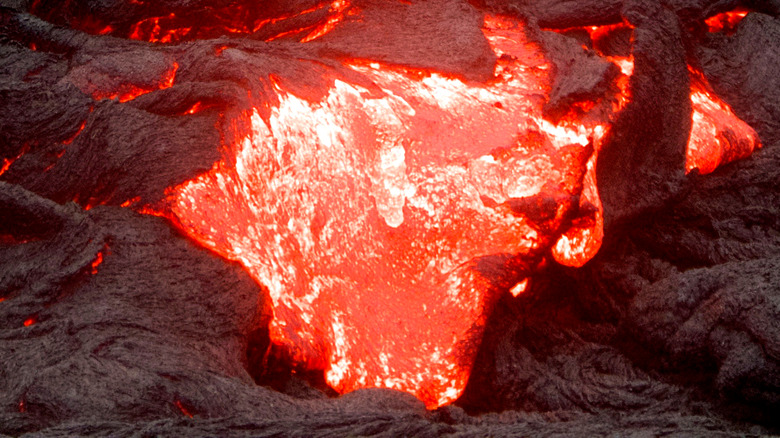
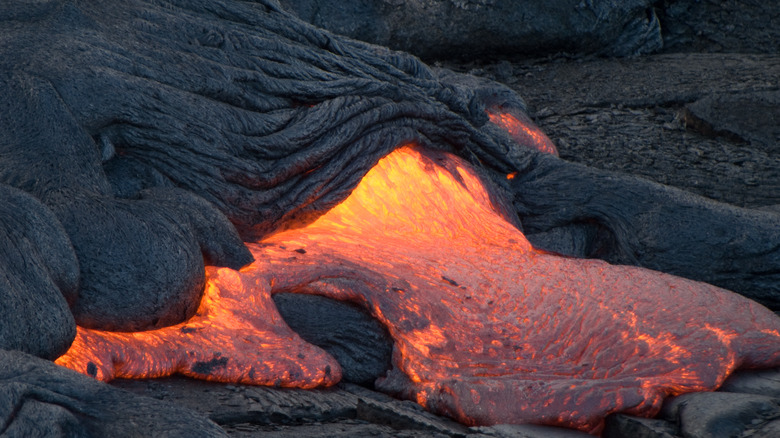
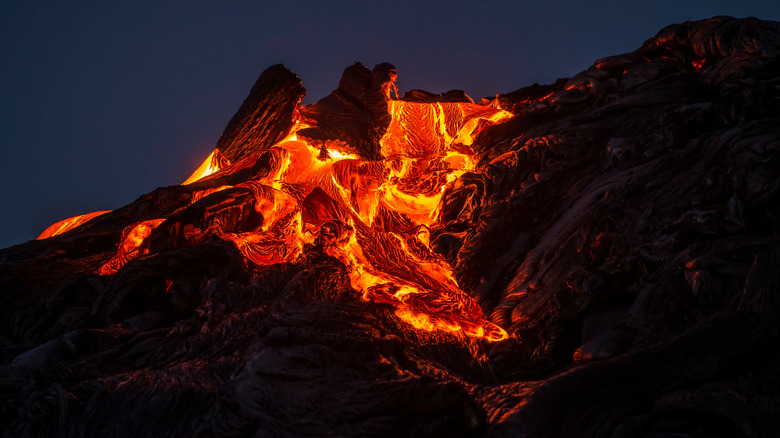
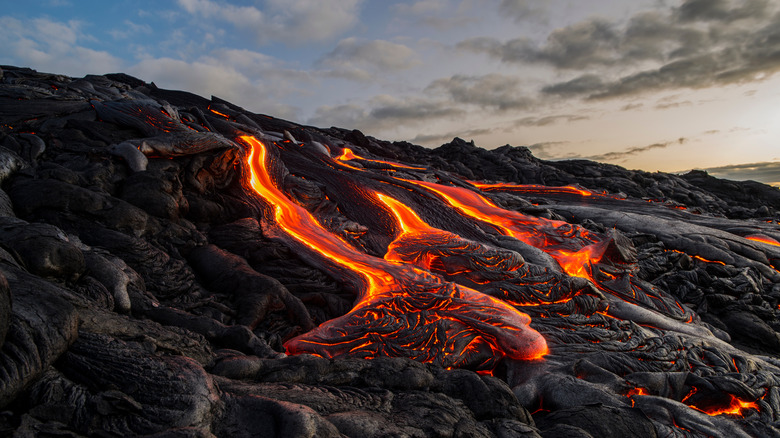
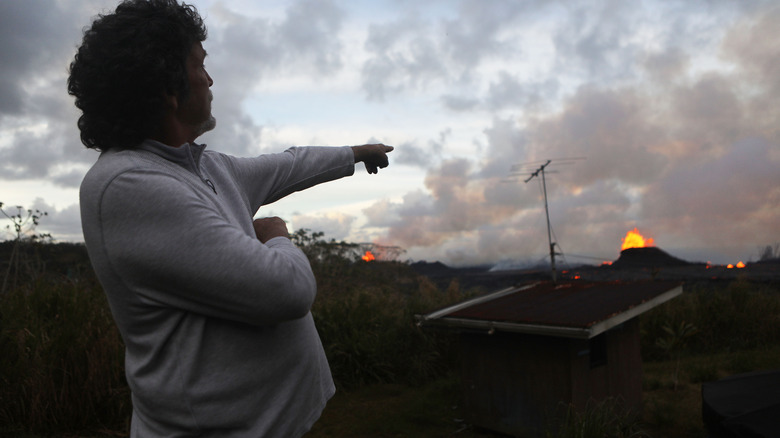
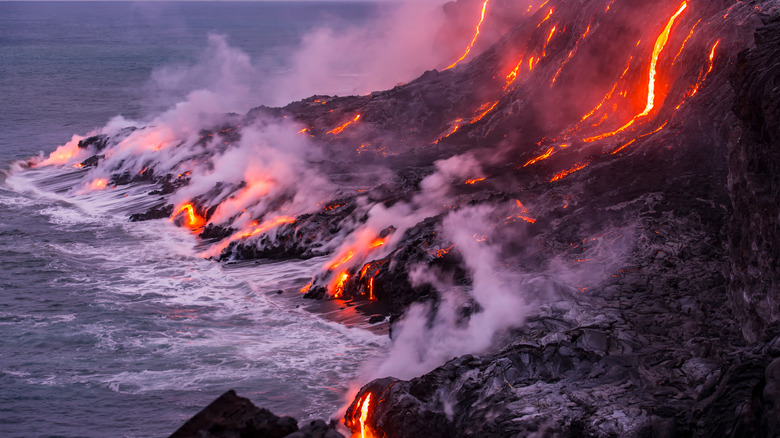
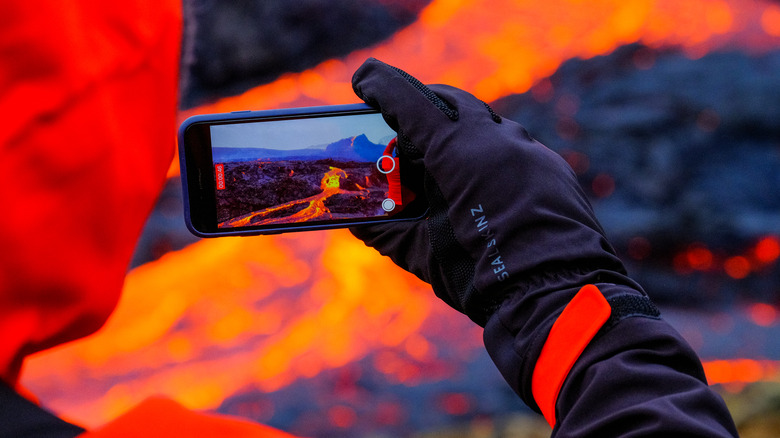
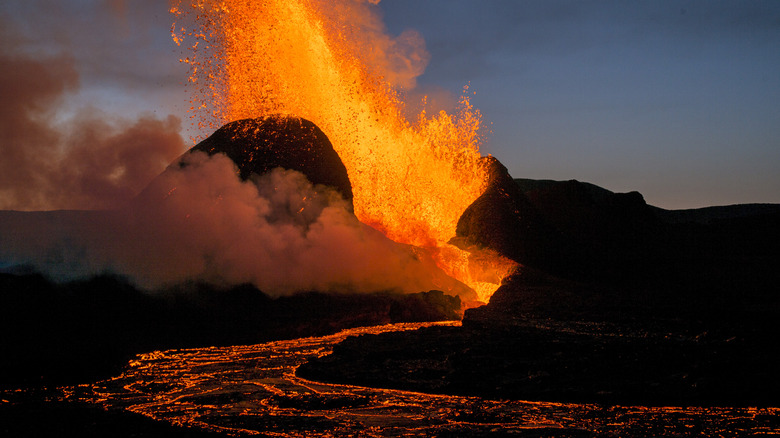

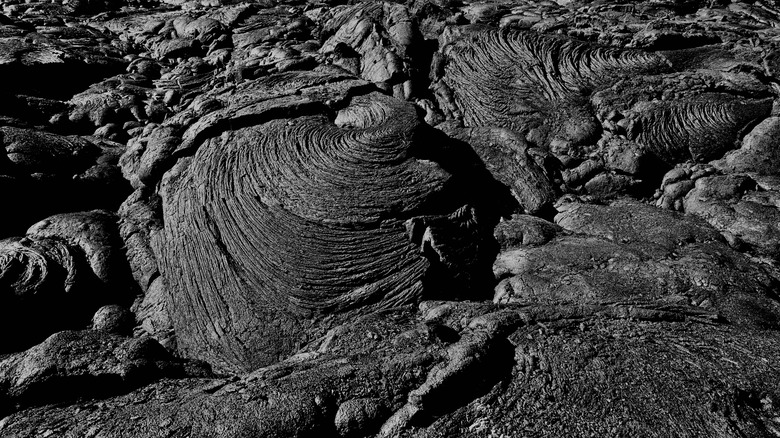
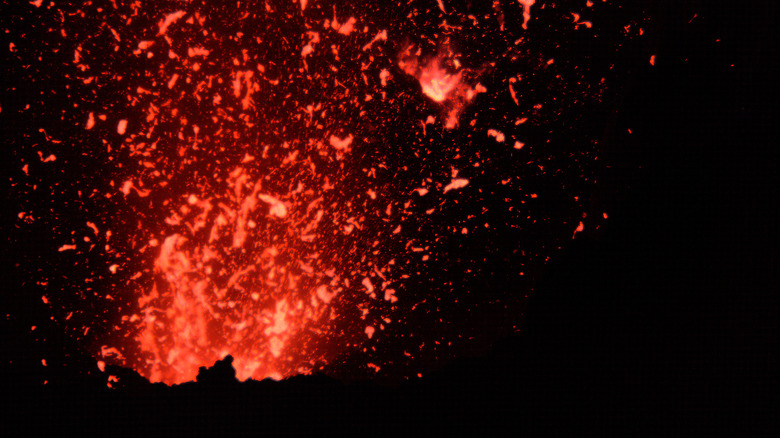
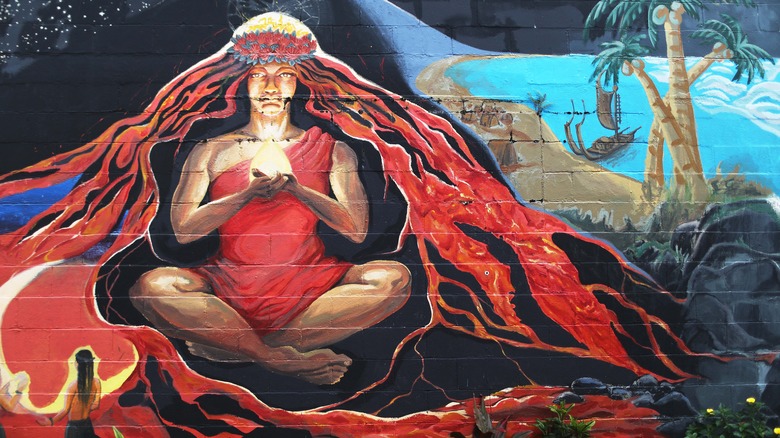


0 Response to "What Happens If Lava Touches Skin"
Post a Comment